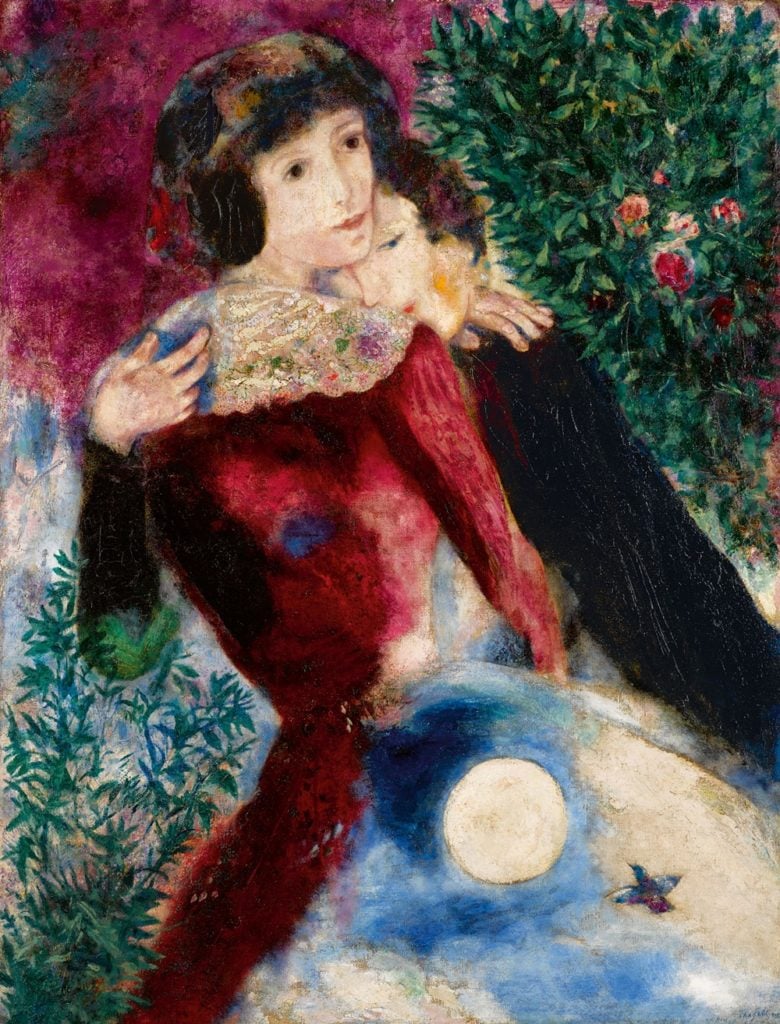
Marc Chagall’s lyrical masterpiece, Les Amoureux will highlight Sotheby’s that New York Evening Sale of Impressionist & Modern Art on 14 November 2017. A stunning image of the artist’s two great loves – his childhood sweetheart and muse, Bella Rosenfeld, and his adoptive home of France – Les Amoureux encapsulates the best characteristics of Chagall’s oeuvre . The work has remained in the same family collection for nearly 90 years, having been purchased from legendary Pari ian gallery Bernheim -Jeune in October of 1928 – the year it was painted.
The enchanting oil on canvas is estimated to sell for $12/18 million during the November Evening S ale. Simon Shaw, Co -Head of Sotheby’s Worldwide Impressionist & Modern Art Department , remarked: “ It is an honor to offer this exquisite painting by Marc Chagall , perhaps his greatest work of the 1920s . Les Amoureux captures at a critical moment one of the most celebrated love stories in art history – the romance between the artist and Bella is palpable, and their happiness is at its very heart . In addition to the painting’s importance with in Chagall’s career, it is truly exceptional to offer a work of this caliber that was acquired so soon after its creation, and which has remained in the same collection since. We have seen a compelling demand for important works by the artist in recent yea rs, an d we look forward to presenting Les Amoureux this fall .” Sotheby’s set the current auction record for any work by Marc Chagall in May 1990, when we sold his 1923 painting Anniversaire for $14 .9 million . Similar in subject matter to the present work , Anniversaire depicts the starry -eyed lovers sharing a kiss while, q uite literally, floating on air .
LES AMOUREUX
The present work fully evokes the devotion and tenderness so present in Marc and Bella’s relationship. Entwined together in the night sky, surrounded by verdant, flowering bushes and a bird soaring through the clouds, the lovers lay engulfed in a dream -like space, with Bella’s dress and skirt saturated with colors of the French fl ag. Chagall’s love for his first wife and most celebrated muse is difficult to overstate. Upon meeting Bella for the first time, the artist wrote of his certainty:
“Her silence is mine. Her eyes, mine. I feel she has known me always, my childhood, my present life, my future; as if she is watching over me, divini ng my innermost being....Her pale coloring, her eyes...They are my eyes, my soul.” *
The artist met Bella Rosenfeld in Vitebsk in 1909 and the couple became engaged within a year, shortly before Chagall’s first trip to Paris in the summer of 1910. During the a rtist’s first four years abroad, he and Bella would correspond frequently and his homesickness for Russia became enmeshed with his desire for his distant fiancée. Following Chagall’s return to Russia and his marriage to Bella, paintings depicting the couple dominated the artist’s work. In 1916 -17, he created four oils of the two embracing on abstracted backgrounds. It was in these years that the couple in flight – a trope that would become one of Chag all’s prime pictorial devices in later years – became firmly established.
Just as Bella inspired many of the works in his oeuvre, France also became a prominent source of inspiration for the artist. Chagall arrived in Paris at the young age of 23; within his first two days, the artist visited the Salon des Indépendants, where he observed works by André Derain, Fernand Léger, Henri Matisse, Pablo Picasso, and Robert Delaunay, who would later become Chagall’s mentor.
During this time, the artist lodged in La Ruche , the legendary block of studios in Montparnasse known for its lively bohemian atmosphere and diverse array of inhabitants, next door to Amedeo Modigliani and Chaim Soutine. It was in this milieu of spontaneity and rich cultural exchange that Chagall began his first period of painting in Paris. Chagall returned to his beloved city with Bella , and their first and only child, Ida ,in September of 1923 and remain ed there until 1941, when World War II forced them to flee to the US.
With his great loves with him in France, Chagall was able to fully enjoy his adopted home country. All of the portraits of him and Bella together during their time in Russia were now imbued with a new -found peace and tenderness in this new stage of their life together. These years in France were particularly fruitful for Chagall , marking a period of comm ercial and critical success, happiness and security . Having returned to the C ity of Light after a nine -year hiatus, the artist found a new equilibrium of mind, a peaceful atmosphere and an audience . Young Surrealists welcomed him back to Paris , and in turn Chagall was pleasantly surprised to find that they supported a changing attitude towards the sort of dream -like poetry painti ng he pioneered many years before. Despite their flattery, Chagall declined the group ’s invitation to join the 4 movement, though his influence can be seen throughout their work , from ambiguous space to collections of objects. The moon and sky of the present work , for example, evoke René Magritte’s composition s of later years.
*This quote was reproduced in J. Baal- Teshuva, ed, Chagall, A Retrospective , New York, 1995, pp.58 -59 #

Also, Georgia O’Keeffe's Yellow Sweet Peas (1925) has a pre-sale estimate of $2.5/3.5 million